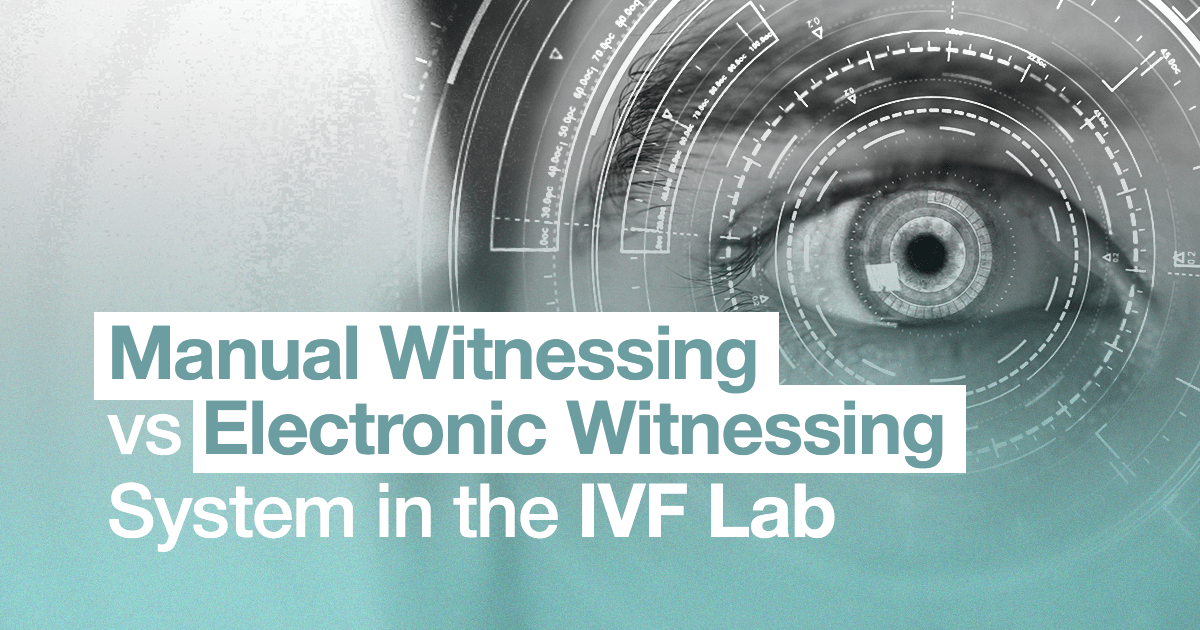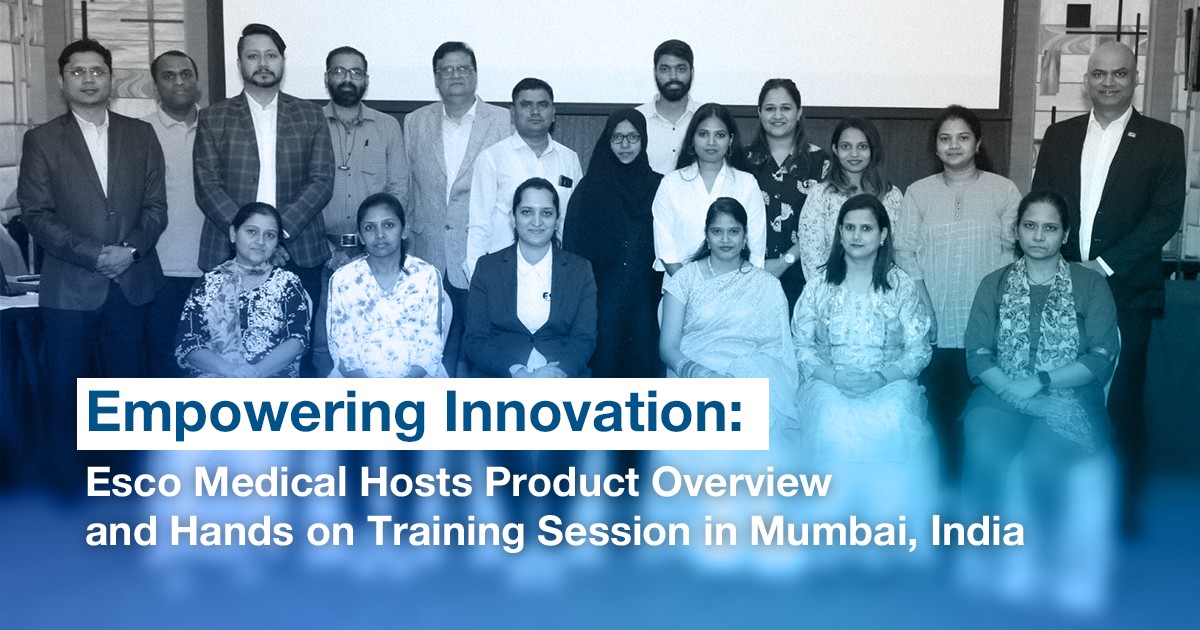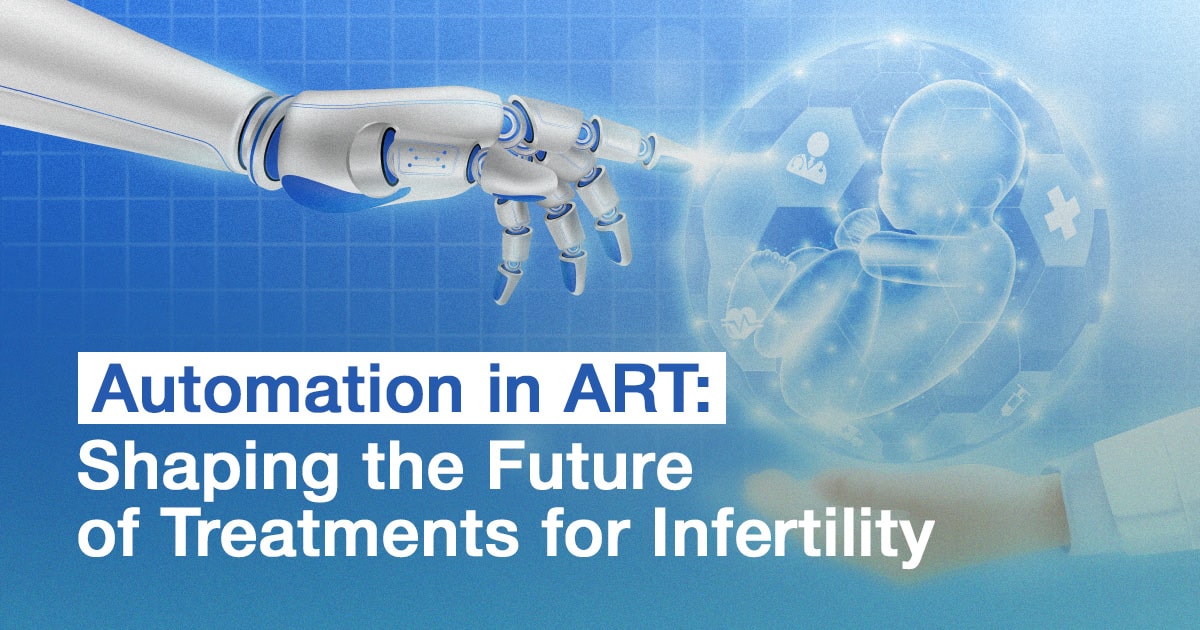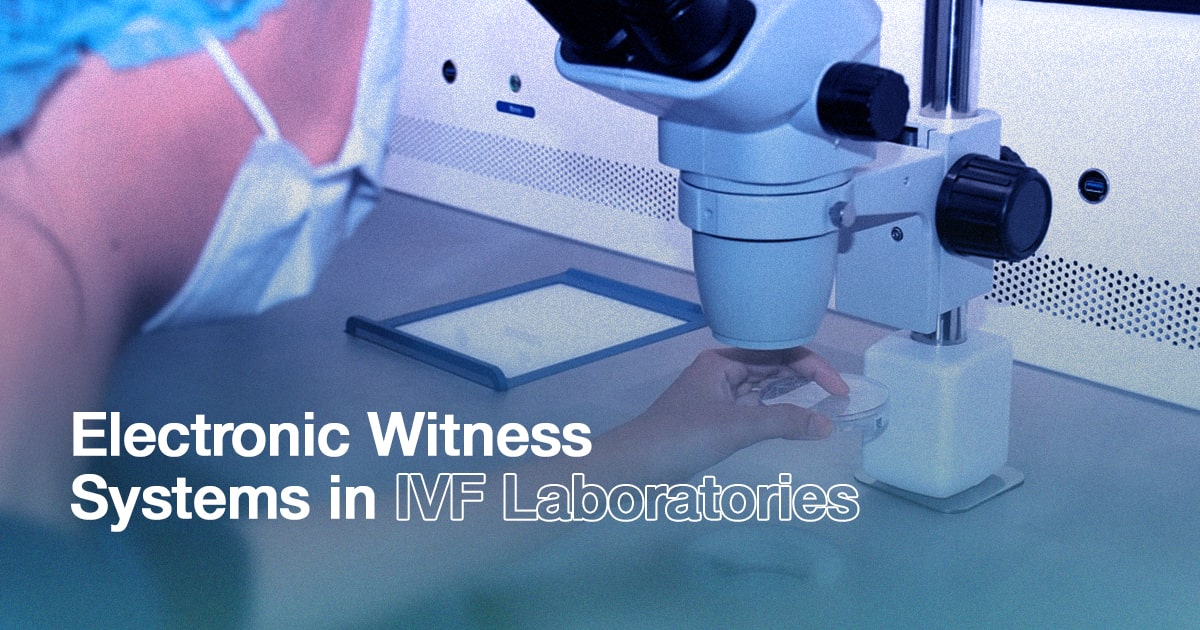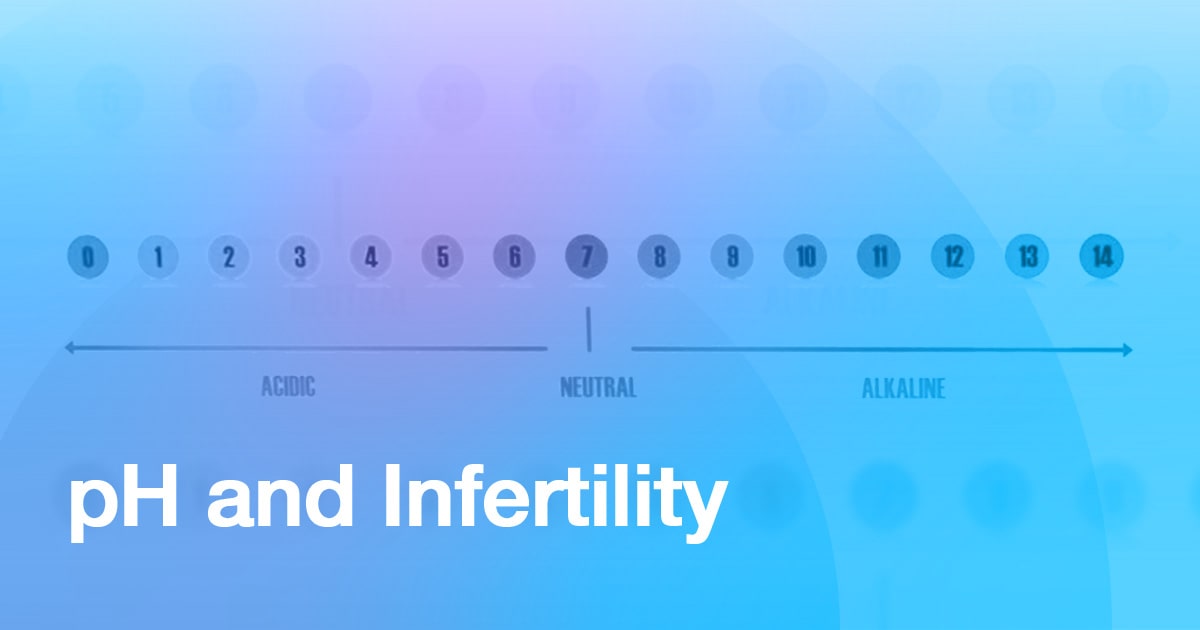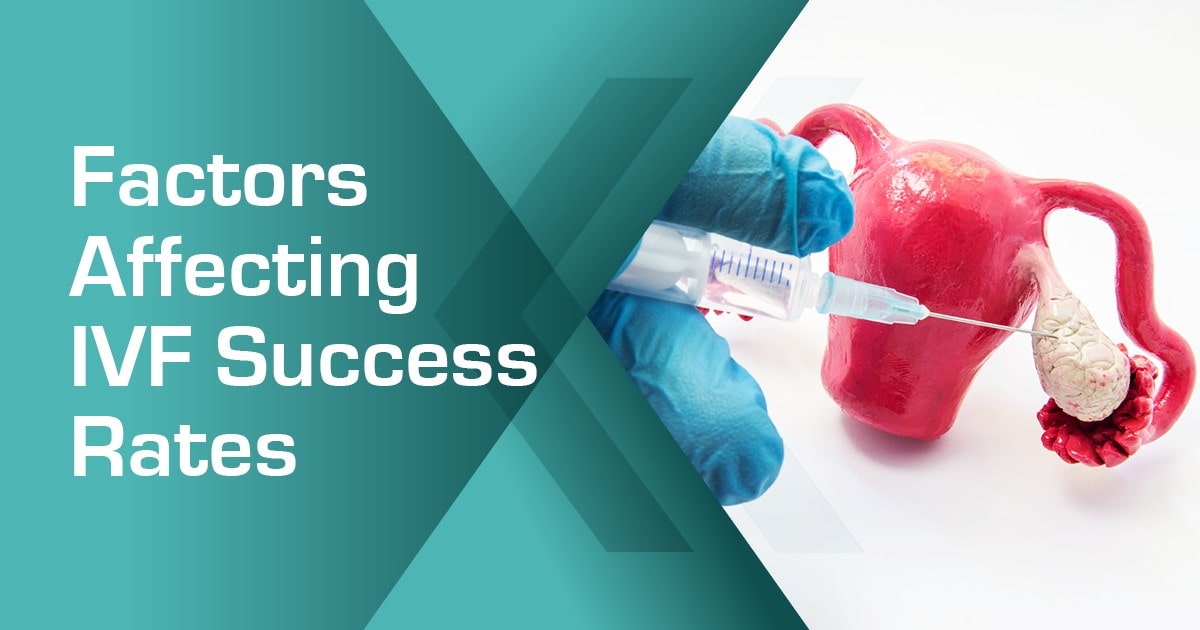
What are the factors affecting IVF Success Rates?
- Age
- The Quality of Egg, Sperm, and Embryo
- History of Previous Pregnancy
- Controlled Ovarian Stimulation Protocol
- Uterine or Endometrial Receptivity
- Embryo Transfer
- Lifestyle Factors
The most successful and most effective fertility treatment or type of Assisted Reproductive Technology (ART) procedure is In Vitro Fertilization (IVF). These are innovative procedures developed in response to infertility. IVF encompasses a set of intricate treatments used to help with fertility, prevent genetic issues, and aid in child conception. It is available practically everywhere in the globe 40 years after its widely criticized clinical debut. There have been more than 8 million babies born worldwide through IVF, and more than 2.5 million IVF treatment cycles are carried out annually, resulting in more than 500,000 deliveries.
In IVF, mature eggs are removed from ovaries and fertilized in a laboratory using sperm. The fertilized egg (or eggs) is/are then transported to a uterus. IVF treatment cycles are completed in roughly three weeks. When these processes are divided into separate steps, the process can sometimes take longer.
As a fertility treatment, IVF is a multi-factorial procedure that is reliant on proper timing and accuracy. All of these elements significantly influence the treatment's ultimate result, a healthy live birth. The significant emotional, physical, and financial toll that goes along with infertility treatments in general, and IVF in particular, necessitates that factors that are known to affect outcome be identified and controlled before treatment is started. The probabilities of a successful IVF treatment depend on the following conditions.
Age
It is said that between 24 to 34 years old, women have the highest likelihoods of a successful IVF treatment since this is the age range when women are considered to be most fertile. However, once a woman reaches the age of 40, the success rate drops
The Quality of Egg, Sperm, and Embryo
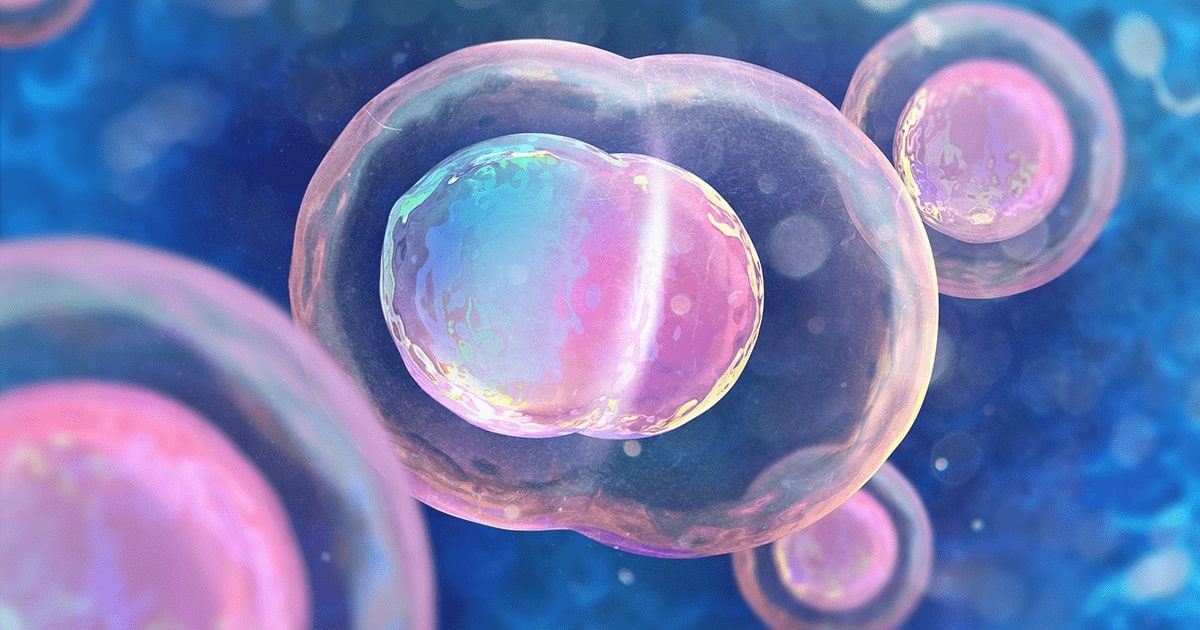
The egg, sperm, and embryo quality are biological factors affecting IVF success rates. Reproductive age has a negative correlation with the success of IVF and has a major impact on egg and embryo quality. Per fresh IVF treatment cycle, the live birth rate is 50% for women under 35 and 25% for those between 40 and 42. The fewer eggs in the ovaries cause a decline in the success rates of IVF and other infertility treatments. After the ages of 32 to 35, there is a faster loss of follicles and eggs, and the reproductive potential is significantly reduced.
An examination of sperm DNA damage in infertile men who have been categorized as having an unexplained condition based on what appear to be normal conventional sperm parameters may also indicate a concealed abnormality of sperm DNA. The data does, however, imply that abnormal semen analysis are more likely to be followed by an abnormal Sperm DNA Integrity (SDI) assay. Thus, it is perfectly suited for fertility clinics to evaluate the integrity of male sperm DNA in relation to fertility potential, embryo development, and the impacts of reproductive toxins. In most circumstances, a high proportion of DNA damage may be used to diagnose the reason for infertility, and SDI data can be used independently of traditional semen characteristics (normal semen analysis).
The value of the oocytes, sperm cells, and the embryos depends on other factors enlisted in this post. fertility factors like age, ovarian reserve, and stimulation protocol affect both the egg cells’ and embryos’ quality. And if the male partner has common fertility related problems, then the treatment process success rate will also be affected.
In the event that the patient’s egg quality is compromised (because of age and other related factors, the use of a donor egg is an option so as to increase the chances of success).
History of Previous Pregnancy

A couple who have had a successful pregnancy outcome in the past indicates a better and higher chance of a positive pregnancy with In Vitro Fertilization. On the other hand, a medical history of multiple and/or recurrent miscarriages and fertility-related issues could mean a more difficult IVF.
Notable fertility issues are as follows:
- Uterine abnormalities
- Presence of fibroid tumors
- Ovarian dysfunction
- Duration of time a couple has had difficulty conceiving.
Controlled Ovarian Stimulation Protocol
Egg and embryo quality may be affected by the technique used for ovarian stimulation. It is believed that genetic factors impact an egg's ability to mature, fertilize successfully, and develop into high-quality embryos that can give birth to a healthy baby. However, several extrinsic factors, including intraovarian hormonal changes during the pre-ovulatory phase of the IVF treatment cycle, might affect how this potential is expressed.
Controlled Ovarian Stimulation Protocol outlines the kind of fertility medications–how they are administered and the schedule or time when they are given. The goal here is to develop several mature oocytes in the optimism that at least one egg cell will result in a succesful pregnancy outcome. The doctor and the patient shall work hand in hand to determine which stimulation protocol is most favorable for the patient. Several ovarian stimulation techniques are now used in IVF. Studies comparing various regimens and fertility drugs are few and do not focus on patient subgroups with distinct infertility causes, age, or illnesses. Most studies include patients with a wide range of infertility causes, and the medical data produced are not stratified based on numerous variables that could significantly affect the outcome.
The timing of ovulation after egg growth and maturation is crucial to ensuring that the eggs are neither too immature nor too mature. Ovulation may occasionally be triggered early in people with PCOS or high responders, which may lead to underdeveloped eggs. In some cases, if stimulation is continued, eggs may overmature and fail to produce viable oocytes. Ovulation should be timed according to each individual's needs.
Long GNRHA Protocols
The "long protocol" is the one that is most frequently recommended for the administration of Lupron and Gonadotropin. One week before the start of the period, lupron is administered. FSH and LH levels initially rise as a result of this, but they quickly drop precipitously to levels close to zero. In order to maintain a relatively "LH-free" environment, gonadotropin treatment is started after uterine withdrawal bleeding (menstruation) and daily Lupron injections are kept up.
Microflare GNRHA Protocols
Microflare techniques offer a different approach to COH. In this case, GnRH agonist administration and gonadotropin therapy are started simultaneously. The purpose is to intentionally cause a spike in pituitary FSH release while taking Lupron, known as a "flare," in order to enhance the ovarian response to the gonadotropin drug. From the start of follicular development, this method's FSH is likely to be accompanied by a corresponding rise in blood LH levels, which could cause excessive ovarian stromal androgen production. The latter could potentially reduce egg quality, especially in older women and in those whose ovaries are more sensitive to LH due to disorders like polycystic ovarian syndrome (PCOS). The potential impact of microflare protocols on endometrial development, egg/embryo quality, and IVF success rates is unknown. As a result, we prefer to stay away from flare protocols that subject the follicles to high intraovarian LH hormone levels during the early stages of follicle development.
GNRH Agonist Conversion Protocols (AACP) With Estrogen Priming
Use of GnRH antagonists as currently recommended in ovarian stimulation cycles, such as the administration of 250 mcg daily starting on the sixth or seventh day of gonadotropin stimulation. This is most common in women with high LH and ovarian stromal overgrowth (hyperplasia), such as women over 40, women with elevated cycle day three FSH, and/or women with low Inhib.
Uterine or Endometrial Receptivity
Just like embryo quality, this factor has a critical role in establishing a succession of healthy pregnancy outcomes of assisted reproduction. In turn, there are influences affecting such receptivity. It includes uterine lining thickness, immunological factors, and the outline of the uterine cavity.
Embryo Transfer
Some IVF professionals believe that the actual embryo transfer procedure is one of the most essential parts of the whole IVF treatment process. Together with a healthy embryo and successful uterine implantation, a faultless transfer is vital. Any difficulty with timing (and even biological factors) can be harmful to the embryo transfer process.
Lifestyle Factors

The patient’s way of life is the biggest external factor that is important in creating a thriving, healthy environment for an embryo. If a patient plans to undergo IVF, one should stop smoking and drinking alcohol at least 3 months before the actual IVF procedure. Studies have shown that smoking and drinking alcohol decrease the chances of IVF success. Another lifestyle factor to consider is keeping a healthy weight. It has been shown that obesity would affect how hormones and fertility drugs are processed by the body. Henceforth, it is essential that a patient is able to control her lifestyle, so that these factors can be dynamically amended.
Myths Related to IVF Success Rates
One of the most widespread misconceptions is that transferring more embryos during an IVF procedure increases the likelihood of success. Contrarily, the human uterus is only designed to accommodate one embryo and one child at a time. Multiple pregnancies are not advised because they can lead to complications for both the mother and the babies. Multiple pregnancies are common practice among fertility experts, resulting in the transfer of two or more embryos after IVF and the birth of twins or triplets. Nowadays, a lot of infertility specialists support elective single embryo transfers.
While the overall global IVF success rate is 35%, several facilities advertise very high lab success rates of 90% or more. The success rates are determined by taking into account a variety of factors, including implantation rates, pregnancy rates, and live birth rates. Additionally, the success rates of IVF will differ from those of other Assisted Reproductive Technology (ART) procedures, such as Intrauterine Insemination (IUI). Intracytoplasmic Sperm injection (ICSI) success rates will also have a different outcome, and the success rate of the first IVF cycle will be lower than the second round, and so on. Therefore, it's crucial to conduct in-depth study to accurately grasp successful pregnancy rates related to IVF, and to not hesitate to openly discuss this with a fertility clinic.
Importance of IVF Incubators
While it is true that a lot of factors rely on the patient’s side, the use of appropriate fertility technologies is another side of the story. Let us look into the importance of incubators.
The principal function of an incubator within the IVF lab is to deliver a stable environment to improve gamete (egg and sperm) function and embryo development in vitro. In short, it serves as the artificial uterus during the in vitro fertilization process. And so as to achieve this goal, an incubator must be able to regulate several environmental variables such as gas concentrations (O2, and CO2), temperature, humidity, and air particulates.
Nature & Importance of IVF
Infertility or genetic issues are treated by different procedures, such as In Vitro Fertilization (IVF) and or Intracytoplasmic Sperm injection (ICSI). IVF is occasionally recommended as the first line of treatment for infertility in women over the age of 40. It may be an option for patients with medical conditions. For instance, it can be a good choice for patients with damage in the fallopian tubes, blockage of fallopian tubes, ovulation disorders, severe endometriosis, uterine fibroid tumors, previous tubal sterilization or removal, low sperm count caused by impaired sperm cell production or function, unexplained infertility, genetic disorders, fertility preservation for cancer or other health conditions. IVF success rates (as well as drops in success rates) are influenced by a variety of variables, which will be elaborated further later in this article.
Treatment for In Vitro Fertilization (IVF) comprises a number of processes, numerous fertility drugs or reproductive medicine, and procedures. Before beginning an IVF procedure, patients must undergo a series of screenings such as ovarian reserve testing to determine the quantity and quality of the eggs by testing the concentration of follicle-stimulating hormone (FSH), estradiol (estrogen), and anti-mullerian hormone in the blood during the first few days of the patient’s menstrual cycle. Other screening procedures include semen analysis to examine the sperm quality, vaginal ultrasound, infectious disease screening, mock embryo transfer, and uterine examinations.
The primary goal of In Vitro Fertilization (IVF) is to give a patient the chance to become pregnant by using her own eggs or from a donor’s oocytes (egg cells) collected during the egg retrieval process, and sperm cells from her partner or from a donor. In order to achieve success in such a complicated process, several factors should be put into consideration.
Esco MIRI Features
The MIRI® Multiroom Incubator has an advanced temperature regulation system for routine and long-term embryo incubation at your fingertips, thereby providing VIP therapy for IVF embryos and, in turn, high IVF success rates.
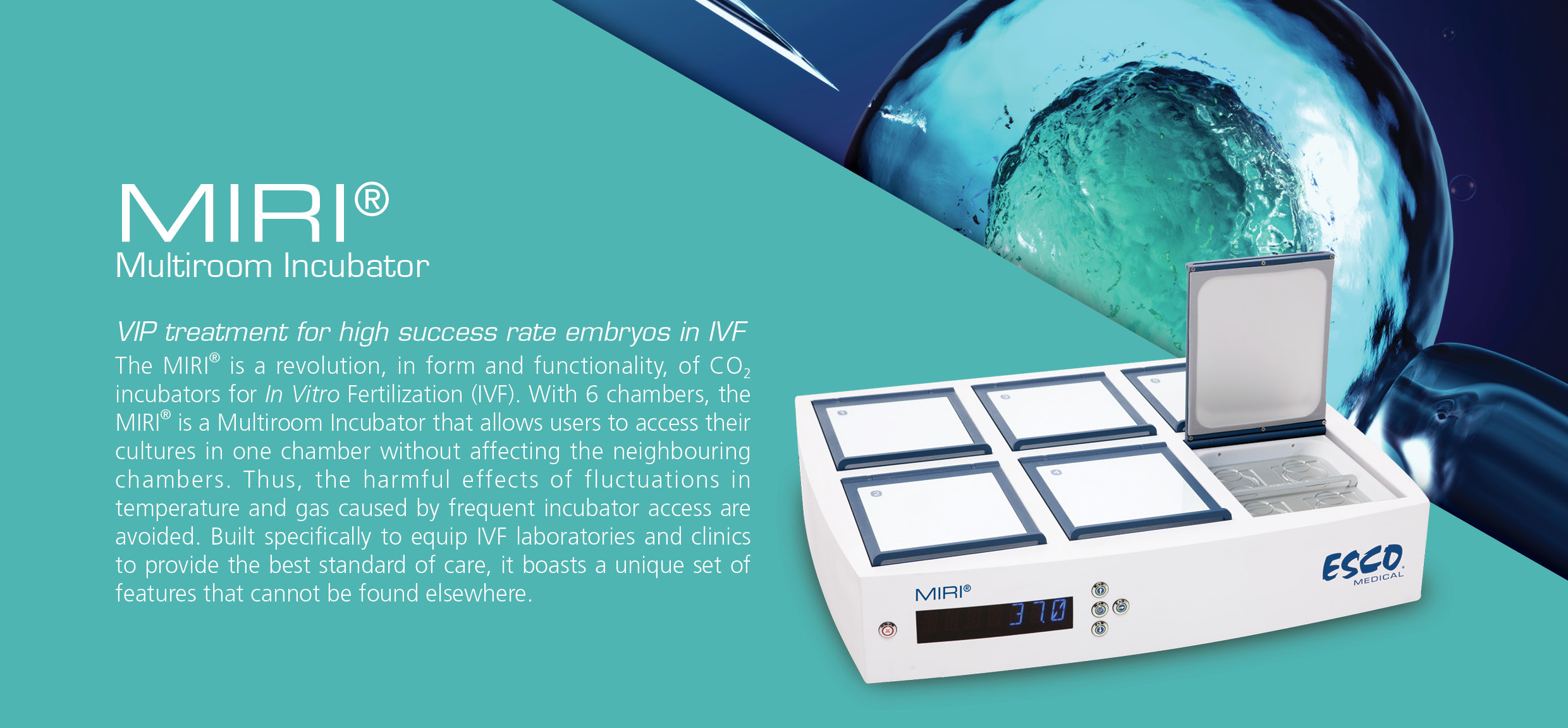
The Esco MIRI® Multiroom Incubator is intended for animal IVF and embryo culture. It has six (6) separate chambers that prevent cross contamination without interfering with the operation of the chambers next to them. Calibration is also made simple since there is no crossover of heat from adjacent chambers. Temperature regulation is completely independent per chamber. The MIRI® also features a total of twelve (12) temperature controlled points, with two points for every chamber: one on the bottom and one on the heated lid which prevents condensation and enhances temperature uniformity across cultured dishes.
The MIRI® offers a special set of characteristics that are exclusive to it and was created especially to fit IVF laboratories and clinics to deliver the highest grade of service. The following are its most remarkable features.

Superior Gas System and Incubation for your Samples
Esco’s MIRI® Multiroom Incubator provides superior incubation and protection for your samples. It is the best option for embryo transfer and securing embryos in your IVF laboratory. It also gives embryologists a larger ability to house more embryos thanks to its six (6) autonomous chambers. Additionally, it makes sure that environmental standards are upheld even when nearby chambers are opened. The temperature is controlled at a very precise level because the temperature deviation is 0.1 C from the setpoint. With its heated lid design, it also provides the best temperature recovery, accuracy, and uniformity in the IVF incubator industry. This feature makes sure that the temperature delivered to your embryos comes from both the top and the bottom of the dish, with a set point of 37.2 C to make sure that your samples receive exactly 37.0 C.
Cost-Effective and Flexible
Flexible gas phase mixing is possible with the MIRI’s dependable gas mixing technology. The MIRI® gas mixer provides complete control over CO2 and O2 concentration levels as well as flexibility regarding the desired gas input. In addition, the HEPA/VOC filter and UV sterilization ensure that only the purest air is circulated to the cultures.
You have the choice of using pure N2 and CO2 gasses, which are less expensive than premixed gasses, and the Esco MIRI® Multiroom incubator recirculates these gas inserts to give you the most value for your money. MIRI® can absorb pure gas; pre-mixed gas is NOT necessary (and even premixed gas if desired). The incubator can reach steady-state gas conditions faster than with premixed gasses when using 100% CO2 and 100% N2. With a 0.2% deviation from the setpoint, the system is very stable and accurate. This is crucial because it will keep the pH stable while the embryo develops.
This feature allows you the freedom to modify your gas concentration when you wish to optimize your lab's procedures for embryo cultivation and embryo transfer.
Six (6) Chambers (Multiroom System)
The MIRI® Multiroom Incubator has completely individual chambers for easier calibration, faster recovery, less disruption, and prevents cross-contamination. It provides embryologists with a larger ability to house more embryos thanks to its six (6) autonomous chambers. Additionally, it makes sure that environmental standards are upheld even when nearby chambers are opened.
The MIRI® Multiroom Incubator is built in a way that causes the least amount of stress possible during embryo transfer and embryo cultivation. Cross-contamination is avoided by the isolated chamber system while the airstream is purified using HEPA/VOC filtering and UV lamp sterilization. Faster temperature and gas recovery are also made possible by the tiny chamber capacities and direct heat regulation.
HEPA/VOC filter + UV for High-Quality Airstream
A HEPA/VOC filter is continuously used to recirculate the gas in the MIRI®. Prior to passing through the filter, the airstream is sterilized by a UV-C light (254 nm). The filter module can be readily changed after use.
pH Measurement
The BNC connector for pH measurement, the USB communication port, and the port for external alarm monitoring are all crucial components of an IVF system. The included software allows the MIRI® to be connected to a PC and use data logging. pH measurement connections to external alarm monitoring systems are also feasible.
Stress-free Validation of Chamber Parameters
The primary circuitry is fully separate from the built-in PT1000 temperature sensors. The six chambers each have a port for sampling gas. For gas and temperature validation, the MIRI® can be connected to an external device like the Esco MIRI® GA.
Data Logging
A user-friendly, feature-rich data logging program that is installed on any PC and connected via USB can connect to the MIRI®. A single computer can link to and control several machines. It is convenient to view all of the machine's real-time parameters. These comprise all set points, input pressures, flow rates, current gas measurements, and temperatures of all monitored temperature and gas concentration points. The machine's performance information, including alerts, is continuously logged and displayed in graphs. Weekly reports are also automatically generated by the data logger, which is more handy for the user.
Heated Lid
The Esco MIRI® Multiroom Incubator prevents condensation and enhances temperature regulation and recovery. It provides excellent uniformity between the top and the bottom, with temperature accuracy at ±0.2 ºC And temperature uniformity at ±0.2 ºC.
With its heated lid design, it also provides the best temperature recovery, accuracy, and uniformity in the IVF incubator industry. This feature makes sure that the temperature given to your embryos comes from both the top and the bottom of the dish, with a set point of 37.2 °C to make sure that your samples receive exactly 37.0 °C.
Heated bottom
The MIRI® Multiroom Incubator provides direct heat transfer to the cultures through the optimization plate for stable heat regulation. It also has removable plates with a wide selection of inserts for better heating optimization, with temperature accuracy at ±0.2 ºC And temperature uniformity at ±0.2 ºC.
Optional SAFE Sens Integration
An Optional SAFE Sens Integration is built into the system to provide continuous pH monitoring. In vitro fertilization (IVF) procedures can use the MIRI® with integrated SAFE Sens technology for quick, accurate, and non-intrusive continuous pH monitoring. The SAFE Sens technology makes use of a disposable sensor and optical fluorescent measurement technology to precisely and consistently track the pH of small volumes of fluids, such as the media used in IVF.
The continuous pH measurement is done through reading and recording every 30 minutes and can be adjusted. A single use sensor probe is also installed and can probe up to seven (7) days of pH readings. Furthermore, a data logging system and user alarms are built into the system that can be connected to multiple incubators. The SAFE Sens is compact and efficient, with no unnecessary openings in the incubators for spot pH measurement.
Control Panel Buttons and LED Display
The MIRI® Multiroom Incubator features a display that can be easily seen from a distance and a control panel that allows easy and intuitive operation. Practitioners of IVF work with priceless, delicate, and sensitive embryos, and frequently, the smallest variables have a significant impact. To provide the best service, the MIRI has a software for the control panel, display, and data logging that is feature-rich and easy to use. Large LED display on the MIRI® makes it simple to see from a distance. The glass lid tops may also be written on, which is a great organizational function. The gas phase composition inside the chambers can also be precisely controlled thanks to the built-in gas mixer and the high-performance CO2 and O2 sensors.
Mute Button
The MIRI® Multiroom Incubator can temporarily mute alarm messages and sound for five (5) minutes. The mute alarm key will still show the alarm condition by blinking red while the alarm is muted.
Total Capacity
Heating plates customized for several types of dishes:
- 4 x Falcon® ⌀ 50/60 mm
- 8 x Falcon® ⌀ 35 mm
- 4 x Nunc™ ⌀ 54/60 mm
- 8 x Nunc™ ⌀ 35 mm
- 4 x VitrolifeDishes
- 4 x LifeGlobal® GPS Dishes
- 4 x SparMED Oosafe® ⌀ 55/60 mm or 4-well Dishes
- 8 x SparMED Oosafe® ⌀ 35 mm
Ordering Information
| MIRI® Multiroom Incubator | ||
|---|---|---|
| Item Code | Model Code | Description |
| Unit | ||
| 2070047 | MRI-6A10-8 | MIRI® Incubator, 230V, 50/60Hz |
| 2070048 | MRI-6A10-9 | MIRI® Incubator, 115V, 50/60Hz |
| 2070086 | MRI-6A10-SS-8 | MIRI® Incubator, with SAFE Sens for pH measurement, 230V, 50/60Hz |
| 2070087 | MRI-6A10-SS-9 | MIRI® Incubator, with SAFE Sens for pH measurement, 115V, 50/60Hz |
| 1320045 | MRI-GA | MIRI® GA CO2 / O2 & Temperature Validation Unit, 115V / 230V |
| Accessories | ||
| 1320191 | MRA-SS-TS | SAFE Sens TrakStation, a tablet with SAFE Sens Software, for pH monitoring |
| 1320011 | MRA-1007 | HEPA/VOC filter (recommended to be replaced every 3 months) |
| 1320018 | MRA-1014 | Stacking frame for 2 units |
| 1320226 | MRA-DRAW | Stacking Frame for 2 Units, With Drawer at the Bottom |
| 1081277 | MRA-SS-SV2 | SAFE Sens SV2 Sensor, Pack of 10 pieces (shelf-life 12 months) |
| 1081278 | MRA-SS-QC2 | SAFE Sens QC2 Alignment Tool |
| Accessories | ||
|---|---|---|
| Item Code | Model Code | Description |
| 132003 | MRA-FD | Insert for Falcon® Dishes |
| 132004 | MRA-ND | Insert for NUNC™ Dishes |
| 1320070 | MRA-VD | Insert for Vitrolife® Dishes |
| 1320099 | MRA-NID | Insert for Nipro™ Dishes |
| 1320100 | MRA-LD | Insert for LifeGlobal® GPS Dishes |
| 1320101 | MRA-PD | Insert Without Footprint for Plain Dishes |
| 1320118 | MRA-OD | Insert for Sparmed - Oosafe® |
| 1320219 | MRA-FD-SS | Insert for Falcon® Dishes, with hole for SAFE Sens |
| 1320220 | MRA-ND-SS | Insert for NUNC™ Dishes, with hole for SAFE Sens |
| 1320221 | MRA-VD-SS | Insert for Vitrolife® Dishes, with hole for SAFE Sens |
| 1320222 | MRA-NID-SS | Insert for Nipro™ Dishes, with hole for SAFE Sens |
| 1320223 | MRA-LD-SS | Insert for LifeGlobal® GPS Dishes, with hole for SAFE Sens |
| 1320224 | MRA-PD-SS | Insert Without Footprint for Plain Dishes, with hole for SAFE Sens |
| 1320225 | MRA-OD-SS | Insert for SparMED Oosafe®, with hole for SAFE Sens |
